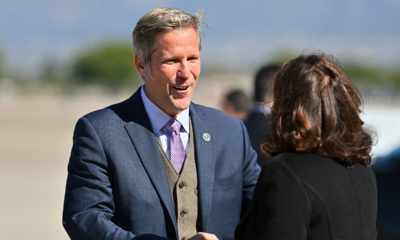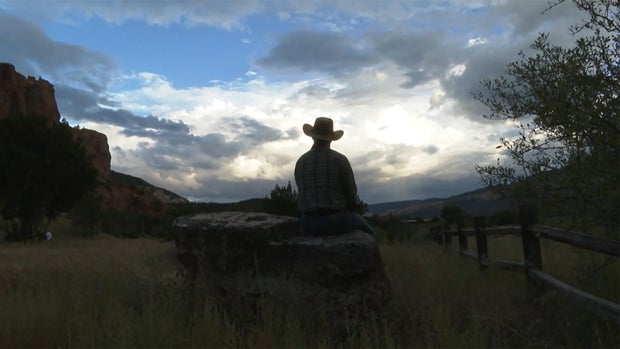New Mexico
Emera Announces Sale of New Mexico Gas Company to Bernhard Capital Partners

This news release constitutes a “designated news release” for the purposes of Emera’s prospectus supplement dated November 14, 2023, to its short form base shelf prospectus dated October 3, 2023.
HALIFAX, Nova Scotia & BATON ROUGE, La. & ALBUQUERQUE, N.M., August 05, 2024–(BUSINESS WIRE)–Emera Inc. (“Emera”) (TSX:EMA), an international energy and services company, today announced it has entered into an agreement to sell its wholly owned operating company, New Mexico Gas Company, Inc. (“NMGC”), to Bernhard Capital Partners (“BCP”), a services and infrastructure-focused private equity management firm, for an aggregate transaction value of $1.252 billion USD, including the assumption of approximately $500 million USD of debt and subject to customary closing adjustments.
“This transaction strengthens Emera’s balance sheet, supports our ambitious capital plan and reinforces our strategic decision to optimize our portfolio and reallocate capital to our highest growth markets to drive long-term value for our shareholders,” says Scott Balfour, President and CEO, Emera Inc. “New Mexico Gas is a strong regulated utility with a customer-focused team. We’re proud of the work we have done together over the past eight years to drive customer growth and enable nearly $800 million USD in strategic capital investments to expand and maintain a safe, reliable system that will serve New Mexicans for decades to come.”
Emera acquired NMGC as part of its acquisition of the TECO group of companies in 2016. Under Emera’s ownership, NMGC has grown and remains the largest natural gas utility in New Mexico, serving over 545,000 customers and safely managing more than 12,000 miles of transmission and distribution pipelines.
“As an operator of premium electric and gas utilities in high-growth jurisdictions, we have compelling opportunities ahead of us, driven by electrification, decarbonization and the need for increased resilience against climate-related challenges,” adds Balfour. “We will move forward to execute on these opportunities with a stronger balance sheet, a more focused operating model and a disciplined capital investment plan.”
The purchase price and transaction value respectively represent approximately 23x last 12 months earnings and 1.42x rate base. Estimated after-tax net proceeds of approximately $750 million USD will be used to repay holding company debt and support its investment opportunities in its regulated utility businesses. The transaction is expected to improve the company’s CFO to debt metrics by 50 bps and reduce its proportion of holding company leverage by 200 bps.
“This investment directly aligns with Bernhard Capital’s strategy to invest in infrastructure assets and utilities that are critical to building more resilient communities,” says Jeff Jenkins, Founder and Partner at Bernhard Capital Partners. “We value the strong history of New Mexico Gas Company and are committed to retaining the invaluable institutional knowledge of its employees. The leadership team and all employees will remain in place after closing, and we anticipate creating approximately 70 new, local jobs. Our priority is ensuring the continuation of reliable, affordable natural gas service to customers and communities across the state. This agreement also reinforces our commitment to fostering economic opportunities and growth in New Mexico. Albuquerque-based Strategic Management Solutions (SMSI), another BCP portfolio company, has operated in New Mexico for 25 years and generated both positive economic growth and job opportunities across the state.”
BCP has an extensive operation footprint across the United States. It also recently announced agreements to acquire multiple leading natural gas LDCs that serve communities in the Gulf South. To date, BCP has invested in nearly 70 companies across 20 platforms, including several utility companies, that collectively employ approximately 20,000 people globally.
The transaction is subject to regulatory approval by the New Mexico Public Regulation Commission (“NMPRC”) and pursuant to the Hart-Scott-Rodino Antitrust Improvements Act. The transaction is expected to close in late 2025, but will not close before September 30, 2025, unless otherwise authorized by the NMPRC.
J.P. Morgan Securities LLC is acting as exclusive financial advisor to Emera in this transaction. Davis Polk & Wardwell LLP is serving as Emera’s legal advisor. Jefferies LLC is serving as the exclusive financial advisor to Bernhard Capital with Kirkland & Ellis LLP serving as their legal advisor.
About Emera
Emera is a geographically diverse energy and services company headquartered in Halifax, Nova Scotia with approximately $39 billion in assets and 2023 revenues of $7.6 billion. The company primarily invests in regulated electricity generation and electricity and gas transmission and distribution, with a strategic focus on transformation from high carbon to low carbon energy sources. Emera has investments in Canada, the United States and the Caribbean.
About Bernhard Capital Partners
Bernhard Capital Partners is a services and infrastructure-focused private equity management firm established in 2013. Bernhard Capital Partners has deployed capital in four funds across several strategies and has more than $4 billion of gross assets under management. Bernhard Capital Partners seeks to create sustainable value by leveraging its experience in acquiring, operating, and growing services and infrastructure businesses. For more information, visit www.BernhardCapital.com.
Forward Looking Information
This news release contains forward‐looking information within the meaning of applicable securities laws, including statements concerning Bernhard Capital Partners’ acquisition of NMGC and the timing for closing. Undue reliance should not be placed on this forward-looking information, which applies only as of the date hereof. By its nature, forward‐looking information requires Emera to make assumptions and is subject to inherent risks and uncertainties. These statements reflect Emera management’s current beliefs and are based on information currently available to Emera management. There is a risk that predictions, forecasts, conclusions and projections that constitute forward‐looking information will not prove to be accurate, that Emera’s assumptions may not be correct and that actual results may differ materially from such forward‐looking information. Additional detailed information about these assumptions, risks and uncertainties is included in Emera’s securities regulatory filings, including under the heading “Business Risks and Risk Management” in Emera’s annual Management’s Discussion and Analysis, and under the heading “Principal Risks and Uncertainties” in the notes to Emera’s annual and interim financial statements, which can be found on SEDAR+ at www.sedarplus.ca.
View source version on businesswire.com: https://www.businesswire.com/news/home/20240805118025/en/
Contacts
Emera Media
Dina Bartolacci Seely
media@emera.com
Bernhard Capital Partners Media
Ed Trissel / Erik Carlson
Joele Frank, Wilkinson Brimmer Katcher
(212) 355-4449

New Mexico
A New Mexico monastery where the silence calls

Thirteen miles down an unmarked dirt road quietly sits the Monastery of Christ in the Desert, along the Chama River in Northern New Mexico. The monastery is home to 15 monks, some livestock, and a guesthouse for people looking for a little quiet in this turbulent world.
“The silence here is deafening,” said Brother John Chrysostom. “No sirens. There’s no electrical buzz or anything. You have no cell phone connection here. The silence allows you the opportunity to hear that which you are to hear.”
That is, the sound of bells, and the sound of voices chanting seven times a day.
“When you chant, that is prayer,” Chrysostom said. “And what any monk probably aspires to do is that he doesn’t want to just chant the Psalm, but one day he wants to be the Psalm. He wants it to be a part of who he is as a human being.”
This part of the world has always drawn people seeking. It drew artist Georgia O’Keeffe to settle just down the road, and in 1964 it drew Father Aelred Wall, a monk, to found a Benedictine monastery here. Famed architect and furnituremaker George Nakashima designed its church.
When we visited, Chrysostom was our “guestmaster,” welcoming us among this order of Benedictine monks. “As guestmaster, I keep this rule: basically we were to treat guests as if they are Christ,” he said.
The brother happens to hold an undergraduate degree from MIT, an MBA, three more Master’s degrees, and a Ph.D. in political science. He was a professor, and also: “I was an investment banker for a while,” he said. “That’s not a very peaceful existence even in the best of times!”
But it was on a pilgrimage, the famous Camino de Santiago, that Chrysostom heard a voice calling him here. Anyone can visit, for a suggested donation and a willingness to participate in the silence.
Here the monks follow the Rule of St. Benedict – Ora et Labora, Latin for prayer and, well, work, which of course you’ll find on YouTube, posted by Brother David. Online, he calls himself The Desert Monk.
And his work around the monastery is never done. “The gist of the message is, in everything that you do, the work is for God,” he said.
When Charles Osgood reported on the monastery in the 1990s, the monks had just begun working with a new invention called the Internet – a union of “inner space with cyberspace.”
Watch the 1996 “Sunday Morning” report: A New Mexico monastery meets the internet (Video)
Today, guests Mary and Joseph Roy, from Washington State, have found something here a five-star hotel cannot offer. “Sun on the red rocks and the River Chama flowing by,” Mary said. “It’s a good way to listen to God, to listen to nature.”
Asked what he takes away from his visit there, Joseph said, “For me, being more aware, listening to that of God in each person, as we talk, as I experience their story and their life.”
The monks ask guests to help with the running of the monastery, if they can, and Brother Chrysostom says their guests’ presence is fundamental to the monks’ calling: “We need the world as much as the world needs us,” he said. “Don’t think we’re escaping or moving away from the world because we don’t need the world. We need the world.”
I asked, “Do you need the world because it helps you feel like you’re fulfilling what God wants you to do?”
“I guess it hearkens back to the desert fathers, the early monks who lived in the Egyptian desert,” Chrysostom said. “You had monks living these holy lives praying, and lives of asceticism, and forgoing eating. It was remarked once like, ‘Okay, you’re doing all this. But whose feet will you wash out here in the desert?’ So, you’re doing these things for someone as well, and with someone.”
But the monks ask no questions of those who wish to become their guests. “No, you just show up as you are,” Chrysostom said. “And you’re not required to do anything while you’re here. You’re just required to be. You can pray with us if you want, you can eat with us if you want. Or you can hike. We ask that maybe, if you’ve chosen to come here, that you spend some time with us getting to know the community and the place. But our schedule’s not your schedule!”
Maybe the quiet of places like Christ in the Dessert isn’t an end in and of itself. But by making space for a little silence, you hear your calling … a little louder.
As Chrysostom pointed out, “One thing you’ll notice that we are in a canyon. So, we’re at 6,600 feet above sea level right now. And so, these hills and the cliffs stretch another 1,000 up and everything. These are all false horizons. Basically, when you get up to the top of these hills, or what you think is the top, you’re just beginning to go up. It continues on. So, this is a false horizon. This is not the top; it’s just the beginning of something which is even higher.”
Perhaps a lesson for all of us on our own spiritual journeys.
For more info:
Story produced by Anthony Laudato. Editor: Chad Cardin.
New Mexico
Unseasonably warm and dry conditions continue across New Mexico

Josh’s Saturday Night Forecast
NEW MEXICO (KRQE) – Record high temperatures were present across large parts of New Mexico today, along with breezy to gusty winds. A cold front has started to move into eastern New Mexico tonight. This will bring breezy winds and slightly cooler temperatures behind it for Sunday. A few record high temperatures are still possible across the western half of the state, though. Temperatures return to the warming trend again early next week, with more record high temperatures likelyon Monday and Tuesday.
A storm system will start to move into western New Mexico by Christmas Eve. It is expected to bring a couple of spotty showers and mountain snow into southwest Colorado. More spotty showers will move into western and northern New Mexico on Christmas Day. Temperatures however are going to stay unseasonably warm across the entire state, with record high temperatures possible on Christmas Day for much of the state.
New Mexico
New Mexico Lottery Mega Millions, Pick 3 Day results for Dec. 19, 2025
The New Mexico Lottery offers multiple draw games for those aiming to win big. Here’s a look at Dec. 19, 2025, results for each game:
Mega Millions
01-11-27-39-59, Mega Ball: 18
Check Mega Millions payouts and previous drawings here.
Pick 3
Day: 6-4-5
Evening: 8-6-5
Check Pick 3 payouts and previous drawings here.
Pick 4
Evening: 2-8-1-1
Day: 0-9-1-3
Check Pick 4 payouts and previous drawings here.
Roadrunner Cash
03-20-25-31-35
Check Roadrunner Cash payouts and previous drawings here.
Feeling lucky? Explore the latest lottery news & results
This results page was generated automatically using information from TinBu and a template written and reviewed by a Las Cruces Sun-News editor. You can send feedback using this form.
-

 Iowa7 days ago
Iowa7 days agoAddy Brown motivated to step up in Audi Crooks’ absence vs. UNI
-

 Iowa1 week ago
Iowa1 week agoHow much snow did Iowa get? See Iowa’s latest snowfall totals
-

 Maine5 days ago
Maine5 days agoElementary-aged student killed in school bus crash in southern Maine
-

 Maryland7 days ago
Maryland7 days agoFrigid temperatures to start the week in Maryland
-

 South Dakota1 week ago
South Dakota1 week agoNature: Snow in South Dakota
-

 New Mexico5 days ago
New Mexico5 days agoFamily clarifies why they believe missing New Mexico man is dead
-

 Detroit, MI6 days ago
Detroit, MI6 days ago‘Love being a pedo’: Metro Detroit doctor, attorney, therapist accused in web of child porn chats
-

 Education1 week ago
Education1 week agoOpinion | America’s Military Needs a Culture Shift




























